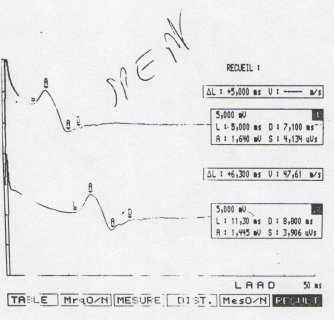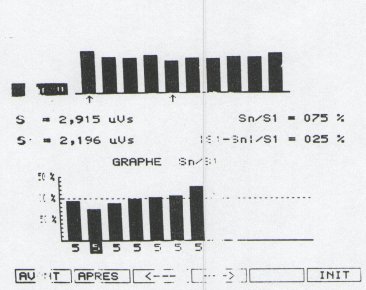CASE REPORT / CAS CLINIQUE
PARTICULAR ELECTROPHYSIOLOGICAL FINDING IN A CASE OF FOODBORNE BOTULISM
- Service de Neurologie et de Neurophysiology, Service de Reanimation Medicale CHU Ibn Rochd. Casablanca, Morocco
E-Mail Contact - KISSANI N. :
SUMMARY
One observation offoodborne botulism with particular electrophysiological finding is reported. A 16 year-old man, with no medical past. He presented typical neurological features of botulism, including progressive weakness and cranial nerve paralysis, following gastroinlestinal symptoms. The electrophysiological study supported the diagnosis with the classical triad, decrease of the motor amplitudes, decremental response to low frequency and a very high incremental response (1400%), to high frequency repetitive nerve stimulation. The diagnosis was confirmed by the mouse inoculation test for toxin. The authors underline the diagnosis value of the electrophysiology in botulism especially the incremental response to high frequency repetitive nerve stimulation, which could be very high.
RESUME
Une observation de botulisine alimentaire avec des donnees electrophysiologiques particulieres est rapporte. Un jeune homme de 16 ans, sans passe medical a presenté un tableau neurologique typique de botulisme, incluant une impotence fonctionnelle progressive avec atteinte des nerfs craniens, suivi de symptomes gastro-intestinaux. L’etude electrophysiologique a clarifie le diagnostic, en montrant la trilogie classique: chute des amplitudes motrices, decrement apres stimulation a base frequence et un increment tres eleve (1400%), apres stimulation repetitive a haute frequence. Le diagnostic fut confirme par le test d ‘inoculation de la toxine a la souris. Les auteurs soulignent la valeur diagnostique de electrophysiologie dans le botulisme, surtout 1’increment apres stimulation repetitive a haute frequence, qui pent etre tres elevee.
Mots clés : Botulism, Diagnosis, Increment
INTRODUCTION
Adult-type botulism is a paralyzing disease. It occurs by ingesting food contaminated with botulinum toxin. The toxin produces skeletal muscle paralysis by producing a presynaptic blockade to the release of acetylcholine. Recent studies have pinpointed the site of action of the several types of botulinum neurotoxin at the nerve terminal (Cherington, 1998). The electrodiagnosis allows quick and reliable confirmation of botulism (Sheth et al, 1999). We present a particular observation of foodborne botulism with very high incremental response to high frequency repetitive nerve stimulation.
CASE REPORT
A 16 years-old man, with no medical past, presented 24 hours after ingesting a sandwich of mortadella, abdominal cramps and vomiting; than four days later, a blurred vision, fever and spittles, than generalized weakeness and hypotonia. His examination five days after the onset showed ab unsteady gait, peripheral paralysis and hypotonia in the four limbs. The tendon reflexes were diffusely abolished. No amyotrophia was noticed and all the sensibilities were normal. Pupils were asymmetrical and dilated; the accommodation, the photo-pupil and the pharyngeal reflexes were abolished; ptosis; extraocular muscle palsies. In addition, weak respiratory effort and urinary retention were also noticed. Botulism was suspected and the electrophysiological study supported the diagnosis with the classical triad: 1-decrease of the motor amplitudes (Figure 1), 2-significant decremental response to 3Hz repetitive median nerve stimulation (Figure 2).
The diagnosis was confirmed by the mouse inoculation test for toxin that found the toxin type C. The patient had been monitored initially in an intensive care unit, to check the vital capacity and to prevent any worsening of the respiratory function. Two weeks later, the recovery started progressively and the patient became clinically free after one month. The electrophysiological control showed a normalization of the motor amplitude, disappearance of the decrement and persistence of a small increment (about 48%).
DISCUSSION
This case of foodborne botulism is very typical clinically, the electrophysiological study showed the three specific elements of the diagnosis: decrease of motor amplitude, the decremental response and the incremental response, to respectively 3Hz and 20Hz of repetitive median nerve stimulation.
The toxin was detected in our case, confirming the botulism. But the serodiagnosis is conclusive just in approximately 46% of clinically diagnosed cases (Shapiro et al, 1998). The reasons of this mild positive reactions are, the low plasmatic toxin concentration and its rapid fixation to the peripheral cholinergic synapses (Shiller and Stalberg, 1978).
In literature, many authors insist on the high diagnosis value of the electrophysiological findings and the specificity of the incremental response, which is a constant finding reported by many authors: Fadel et al, 1999 found a constant increment in a large Moroccan series of 16 patients with foodborne botulism, the serodiagnosis was conclusive in only 9 cases (personal work). Zouari et al, 1997 studied the contribution of electromyography in one case with botulism, which improved clinically and electrophysiologically; the incremental response was 291% at the onset, and 38 % one month later. Many other authors insisted on the constancy and specificity of the incremental response at high frequencies, versus the non specificity of the decremental response at low frequencies, which is not a reliable sign (Shapiro et al, 1998; Guitirez et al, 1994). These two signs added to decreased amplitude of action potentials constitute the classical electrodiagnostic triad, which is more constant than the serodiagnosis. Single fiber electromyography is more sensitive in electrodiagnosis of butalism, especially in mild forms (Shiller and Stalberg, 1978). In infantile botulism, the situation is less simpler because of the pitfalls in electrodianosis (Sheth et al, 1999). The 1400% of incremental response is very high in our case, such a spectacular increment has not been described as far as we know. We postulate meanwhile this concerns just one case the non prognosis value of the high increment, because of the good prognosis in our case.

Figure 1

Figure 2

Figure 3
REFERENCES
- CHERINGTON M. Clinical spectrum of botulism. Muscle Nerve-1998; 21 (6): 701-710.
- FADEL H., K1SSANI N., RAFA1 M.A., Clinical and Electrophysiological study of 16 cases of foodborne botulism. Communicated in the autumn journey of the Moroccan society of Neurology, 4/12/1999.
- GUITIREZ AR, BODENSTEINER J, GUTMANN L. Electrodiagnosis in infantile botulism: J Child Neurol-1994; 9:362-365.
- SHAPIRO ROGER L., HATHEWAY C, SWERDLOW DL. Botulism in the United States: A clinical and Epidemiological Review. Ann In tern Med. 1998; 129: 221-228.
- SHETH RD; LOTZ BP; HECOX KE; WACLAWIK AJ. Infantile. botulism: pitfalls in electrodiagnosis. J.Child Neurol-1999; 14(3): 156-158.
- SHILLER HH, STALBERG E. Human botulism studies with single-fiber electromyography. Arch Neurol: 1978; 35: 346-349.